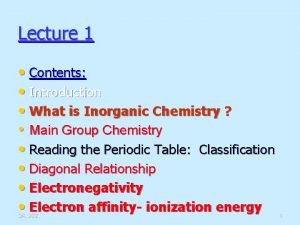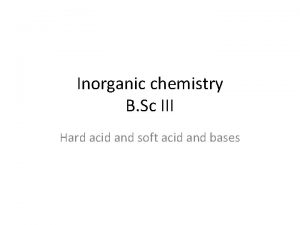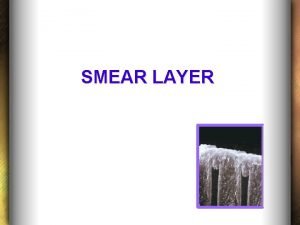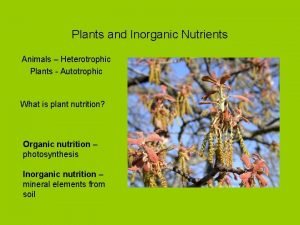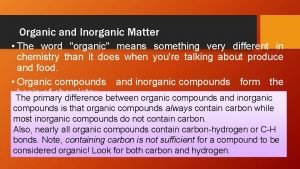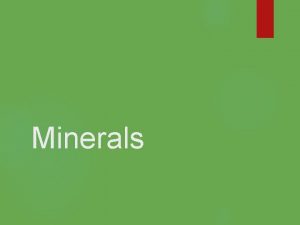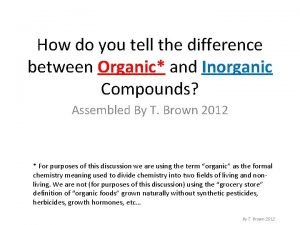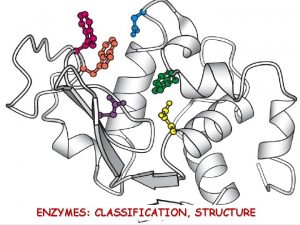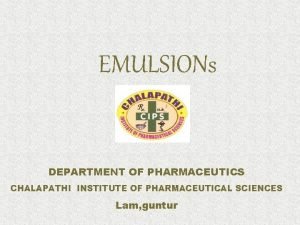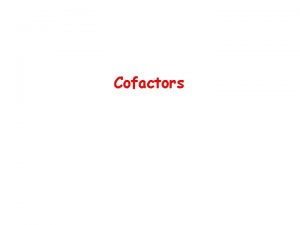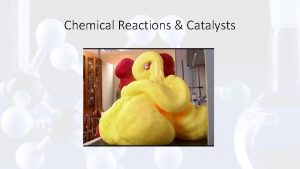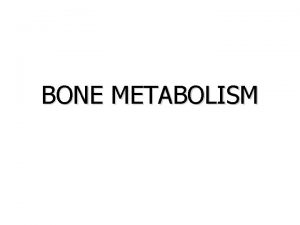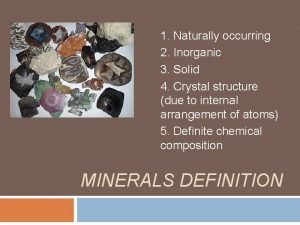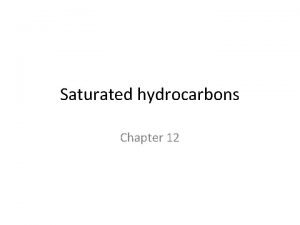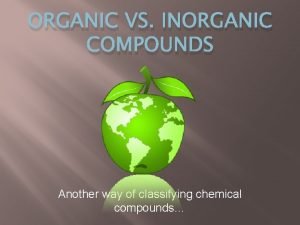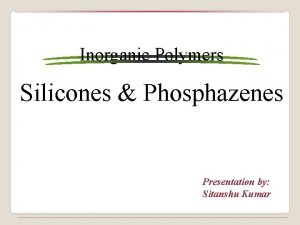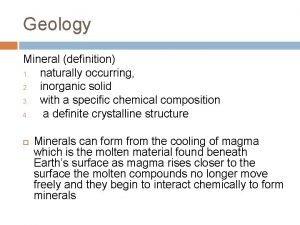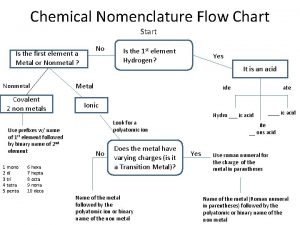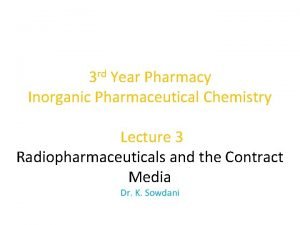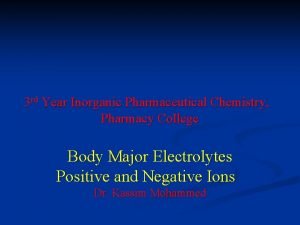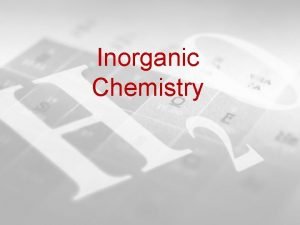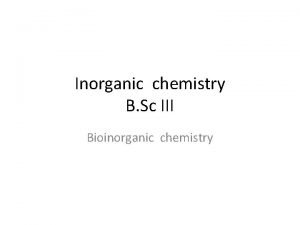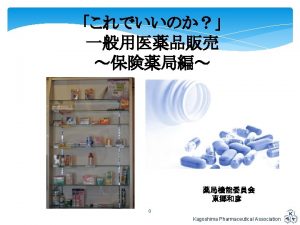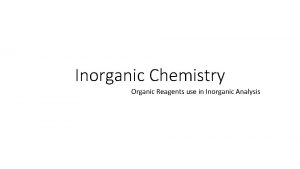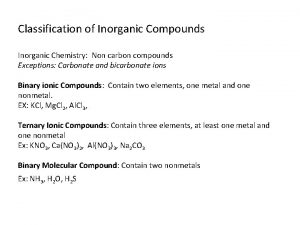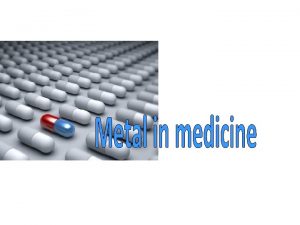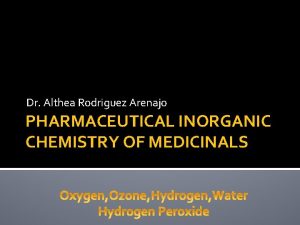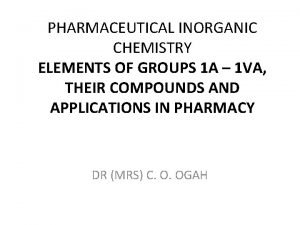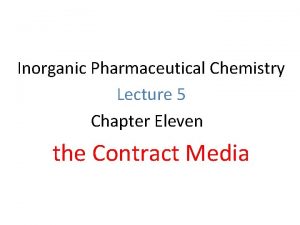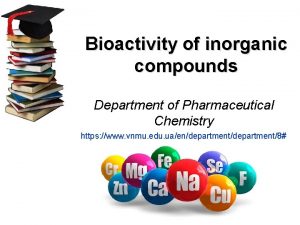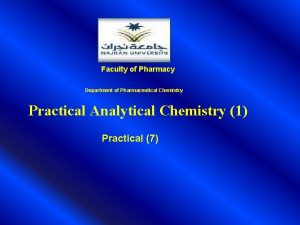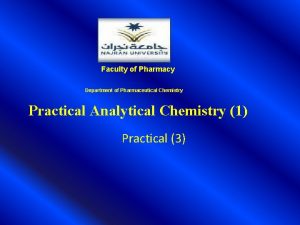3 rd Year Pharmacy Inorganic Pharmaceutical Chemistry 2018


































- Slides: 34

3 rd Year Pharmacy Inorganic Pharmaceutical Chemistry 2018 -2019 Lectures 1 and 2 Atomic and Molecular Structure / Complexation (slides 1 -34) Dr. Kassim Mohammed.

Basic Concepts/ Electronic Structure of Atoms -Subatomic Particles and their properties -Atomic Orbitals - Quantum numbers - Representation of Atomic Orbitals - Atomic Orbital filling applying Hund’s rule and stability considerations e. g. Cr and Cu with z= 24 and 29 respectively.

Ionisation The Periodic Law Electronegativity, definition and order Electronic Structure of Molecules; δ, л, n, л*, δ* Columbic attraction, electron –electron Repulsion and nuclear repulsion Covalent; sharing of electron pairs Ionic; electrostatic interaction

Orbital Hybridization- It involves mixing of atomic orbitals to provide a new set of degenerate orbitals having different spatial orientations and directional properties than the original atomic orbitals. Examples using Be, B and C including shapes and properties, p 20. sp, sp 2, sp 3, d 2 sp 3 The effect of ligand strength and the magnetic properties of the complex in determining shape e. g. octahedral, tetrahedral or square planar.

Types of Bonding Interactions Ionic, e. g. sodium and calcium chlorides Covalent, e. g. hydrogen, chlorine, carbon, hydrocarbons, phosphorus, carbon dioxide and hydrogen cyanide. Coordinate Covalent Bonding, e. g. in borontrifluride etherate. Q: What determines the nature of a bond?

Hydrogen Bonding Hydrogen bonding is a weak secondary interaction usually intramolecular and also intermolecular. It explains some of the unusual properties of water such as its relatively high boiling point. It is also important in describing the structures of proteins and nucleic acids To form a H-bond, there must exist a hydrogen atom attached directly to one of the three atoms F, O or Nitrogen. These atoms have high electronegativities.

Van der Waals Forces Van der Waals forces are weak intermolecular forces to explain important phenomena including halogens and hydrocarbons as well as drug – receptor. These interactions depend on masses and distance between molecules.

Other types of Interactions Polar interactions as well as induced dipole interactions are week forces. However, they are important in explaining some properties of compounds as well as drug – receptor interactions and the relative stability of some isomers.

Polarisation Apart of the extreme cases of pure covalent bonding of homonuclear diatomic molecules and pure ionic bonding between G I and G VII atoms, these is always varying degrees of ionic or covalent character described in terms of polarity. The later depends on; 1. polarisabilty, highest for cations of high q/r • 2. polarising power, highest for anions of high q/r • 3. dipole moment, difference in electronegativities.

Coordination Compounds Metallic cations, especially the transition metals are able to form stable compounds with additional anions or molecules with lone pair(s) of electrons, ligands, to form complexes. The maximum number of sites of the central metal occupied is called the coordination number. The metal and its associated ligands is called the complex ion. The later with its counter ions is called the coordination compound.

Coordination Compounds…. . continued • The stability of a complex depends on the metal ion and the basicity of the ligand, Lewis’s concept. • (Table 1 -8) • Ligands can be bidentate, tridentate, tertradentate, hexadentate or octadenate (Table 1 -9) •

Warner’s Theory Q 1: Comment on the complex of silver ion with ammonia. Q 2: describe the coordination compounds formed when iron(III) chloride is added to; a. Water, b. Hydrochloric acid c. sodium hydroxide solution. Q 3: State the main points of Warner’s theory.

Bonding in Complexes The valence bond theory is used to obtain a quantitative picture of bonding in complexes. The theory uses the idea of hybridization of the central metal atomic orbitals. The orientation of the five d orbitals of the metal in a complex is made of two sets. The d x 2 -y 2 and dz 2 orbitals are oriented along the axes of the Cartesian coordinate system. The other three; dxy, dyz and dxz are directed between the axes.

Octahedral Complexes, 1 -3 electrons For transition metals containing 1 -3 electron in the d orital e. g Cr+3 complexing with six cyano, CN- ions to form Cr(CN)6 -3. Chromium (III) is a d 3 ion; that is it contains 3 electrons in the in its 3 d valance orbital. These electrons are unpaired and occupy the three off-axis d orbitals, thus leaving two d, one s and 3 p orbitals empty for bonding with six cyano groups. If these six orbitals hybridize six equivalent orbitals are formed and will be occupied by the six lone pairs of electrons donated by the six cyano ligands.

Octahedral Complexes, 4 -6 electrons When four or more electrons in the outer d orbital, for example complexes formed with iron(III) which is a d 5 ion, the normal ground state arrangement of electrons use different orbitals for bonding. In hexaaquoiron(III) which is a high spin complex, with similar magnetic moment as the free ion, hybridization of six orbitals (five 4 d, one 4 s, and three 4 p) called outer orbital hybridization, sp 3 d 2 instead of the usual sp 3 d 2 hybridization.

Octahedral Complexes, 4 -6 electrons- high field If the water molecules in hexaaquoiron(III) complex ion are replaced with cyano groups, the hexacyanoferrate (III) ion results which has lower magnetic moment, a low spin complex. This is a result of the high magnetic field of the cyano groups of sufficient strength to repel the electrons in the two d orbitals which directly oppose the approaching ligands. The electrons become paired with those in the other d orbitals. Pairing with the six orbitals of the ligands will result in a low spin octahedral complex.

Complexes with 7 -9 d electrons Transition metal ions with seven, eight, or nine d electrons generally have coordination number of 4 which leads to either a square planar or a tetrahedral arrangement of the ligands. The strength of the ligand the formation of high – and low spin complexes may be predicative of the type of hybridization and therefore the geometry of the complex.

Complexes with 7 -9 d electrons, …. . continued For example a d 8 ion complexing with a ligand having a relatively weak electrostatic field has no d orbitals available for bonding. However, the ligands can bond through the four sp 3 hybrid orbitals formed on the metal to give a tetrahedral complex. A strong ligand will force the metal into a low spin state and a square planar resulting from dsp 3 hybridization will be formed. The complex has one vacant d orbital.

Complexes and Chelating Agents Chelating agents are important aspects of pharmacy, drug therapy. They have much efficacy in the treatment of heavy metal poisoning for elements such as leas, arsenic, mercury and iron. Chelating agents are important in treatment of metabolic disorders where metals such as iron and copper are accumulated in abnormal amounts in various tissues. Examples of important chelating agents include EDTA, BAL, penicillamine and deferoxamine.

Calcium Disodium Edetate

Disodium Edetate

Dimercaprol

Penicillamine

Desferroxamine

Calcium Disodium EDTA The disodium salt of EDTA is is a mixture of the dihydrate salt. It is a white crystalline granules or powder. It is odorless, slightly hygroscopic and has a faint saline taste. It is stable in air, soluble in water with p. H between 6. 5 and 8. 0. It is used in the treatment of heavy metal poisoning especially plumbsim and other metals but not for mercury arsenic or gold. An increase in the excretion of metal in the urine by 500 ug/liter/24 hr is an indication of poisoning. It induces hypocalcaemia states. Doses are IV or IM of 75 mg/kg of body weight. Preparation; a solution containing 200 mg/ml for injection.

Disodium Edetate Disodium edetate is a white crystalline powder which is soluble in water and has p. H of 4. 0 -6. 0. It is used in treatment related to hypercalcemia including occlusive vascular disease and cardiac arrhythmias. It is not useful for dissolution of urinary calculi. Doses; IV injections of 50 mg/kg of body weight. Preparation; 150 mg/ml for injection. I

Dimercaprol is a colorless of mercaptan-like odor. It competes with enzymes containing sulfhydryl groups (responsible for oxidation-reduction) for the metals causing poisoning. The mercatides formed are excreted in the urine. BAL is of value in the treatment of arsenic or gold poisoning and early mercury poisoning, within a few hours.

Dimercaprol Dose: in severe arsenic or gold poisoning , 3. 0 mg/kg is given six times a day for two days, four times a day on the third day, then twice daily on the next ten days. For early mercury poisoning, 5. 0 mg/kg followed by 2. 5 mg/kg twice daily for ten days. Preparations: IM imgectio of 100 mg/ml in peanut oil.

Penicillamine Pencillamine is a white crystalline powder having characteristic odor. It is freely soluble in water with p. H of 4. 5 -5. 5. Pencillamine is used for treatment of poisoning of many metal including lead, iron, mercury and gold. Pencillamine is is used for treatment of hepatolentecular degeneration (degeneration of the brain associated with increased levels of copper and Wilson’s disease which is associated with elevated levels of copper in tissues including; eye, liver, brain and kidney.

Uses of penicillamine …. continued Pencillamine is used in the treatment of gold dermatitis. Pencillamine is used in the treatment of cystinurea, the presence of crystals of cystine in urea. Dose: 250 mg capsules given four times a day. Preparations: Cuprimine capsules containing 250 mg of penicillaime for oral administration.

Effectiveness of Penicillamine The effectiveness of pencillamine as compared to is attributed ; 1. 1. its ability to resist metabolic inactivation by aa oxidase since it doesn't have a hydrogen on the beta carbon atom. 2. 2. its sulfhydryl group ability to convert Cu+2 to Cu+, with the formation of a tetrahedral rather than a square planar complex which has less affinity in competition with the tissue proteins containing –SH groups of oxidative value.

Deferoxamine mesyalte Deferoxamine is for acute iron deficiency. It forms an octahedral complex with Fe+3. It has no affinity to divalent ions including Fe+2. Deferoxamine is not soluble in the gastrointestinal tract so oral administration is not effective.

Deferxamine……continued. It is produced by streptomyces as as a ferric Fe(III)complex. After chemical removal of the iron, the chelating agent is purified as the methyl sulphonate salt. Dose: IV or IM injections of 1. 0 g followed by 0. 5 g every 4 -12 hours. Preparations: Desferal ampules containing 500 mg of the lyophilized powder for injection.

Thank You
 Importance of inorganic chemistry
Importance of inorganic chemistry Inorganic vs organic chemistry
Inorganic vs organic chemistry Advanced inorganic chemistry lecture notes
Advanced inorganic chemistry lecture notes Organic vs inorganic
Organic vs inorganic Introduction to inorganic chemistry
Introduction to inorganic chemistry Is inorganic chemistry hard
Is inorganic chemistry hard B a f c j e
B a f c j e January 2016 chemistry regents answers
January 2016 chemistry regents answers Our tiny feet poem
Our tiny feet poem Ib organic chemistry
Ib organic chemistry Smear layer dental definition
Smear layer dental definition Charring test of organic and inorganic compounds
Charring test of organic and inorganic compounds Inorganic plants
Inorganic plants Which compound is inorganic
Which compound is inorganic Organic chemistry introduction
Organic chemistry introduction Organic molecules vs inorganic molecules
Organic molecules vs inorganic molecules Meaning of the word organic
Meaning of the word organic Veins are often formed from hot water solutions
Veins are often formed from hot water solutions Organic and inorganic cofactors
Organic and inorganic cofactors What is the difference between organic and inorganic
What is the difference between organic and inorganic Six classes of enzymes
Six classes of enzymes Inorganic emulsifying agent is
Inorganic emulsifying agent is Organic and inorganic cofactors
Organic and inorganic cofactors Inorganic catalyst vs enzyme
Inorganic catalyst vs enzyme Organic matrix of bone
Organic matrix of bone Inorganic nomenclature worksheet
Inorganic nomenclature worksheet Inorganic gaseous pollutants of air
Inorganic gaseous pollutants of air Inorganic mineral definition
Inorganic mineral definition Unsaturated hydrocarbon
Unsaturated hydrocarbon Organic vs inorganic compounds
Organic vs inorganic compounds What is polymeric backbone in silicones and phosphazenes
What is polymeric backbone in silicones and phosphazenes Inorganic gaseous pollutants of air
Inorganic gaseous pollutants of air Inorganic geology definition
Inorganic geology definition Inorganic content of calculus
Inorganic content of calculus Flow chart nomenclature
Flow chart nomenclature




